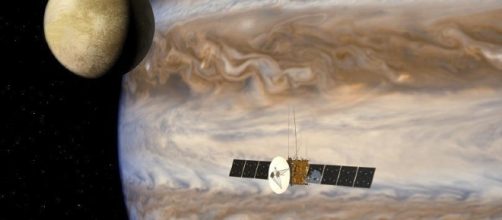As it turns out, the Europa Clipper is not the only space probe slated to head for Europa in the 1990s. The European Space Agency is preparing the JUpiter Icy Moons Explorer (JUICE) for a launch in 2022 and arrival in Jupiter space in 2029. JUICE will spend four years studying the atmosphere of Jupiter as well as her major moons, Europa along with Io. Callisto and Ganymede. NASA is a partner in the expedition and has provided one of the ten instruments to be carried aboard as well as components for two others.
The instrument that NASA is providing is called the Ultraviolet Spectrograph (UVS), designed to study the dynamics and atmospheric chemistry of the Jovian system, including its moons.
The two instruments NASA is providing components for are the Particle Environment Package (PEP) and the Radar for Icy Moon Exploration (RIME). The PEP is actually six instruments that will map the system of plasma that surrounds Jupiter. The RIME is a ground penetrating radar that will study the structure below the surface of Jupiter’s moons.
The NASA contribution to the mission just passed the Key Decision Point C (KDP-C) which clears the way for the construction of the instruments. The Critical Design Review will take place in a year. NASA’s overall cost in $114 million.
JUICE is not considered competitive to Europa Clipper but rather complimentary as they are directed to two different missions.
Europa Clipper is designed to study the habitability of Europa and to prepare the way for the Europa Lander, should it be funded. JUICE is intended to examine the major Moons Of Jupiter as a system
The recent attention being paid to the moons of the Outer Planets represents a growing realization on the part of scientists that the icy moons of Jupiter and Saturn may be venues for life, swimming in warm oceans underneath the ice crust.
NASA recently announced the results of studies that buttress this theory concerning Saturn’s icy moon Enceladus and Europa.
For decades, Mars has been thought to be the world most suitable for life. However, numerous space probes, while uncovering tantalizing hints of previous or past life on Mars, have never found anything resembling a life form.
Such may exist on the Red Planet, but the hunt has proven to be elusive.
Now, with the theory that numerous worlds in the outer solar systems harbor warm water oceans underneath ice layers, the search for alien life has shifted outward from Mars to some extent. It could be that the first extraterrestrial lifeform to be discovered by humans will be underneath the surface of Europa or some other icy moon.

